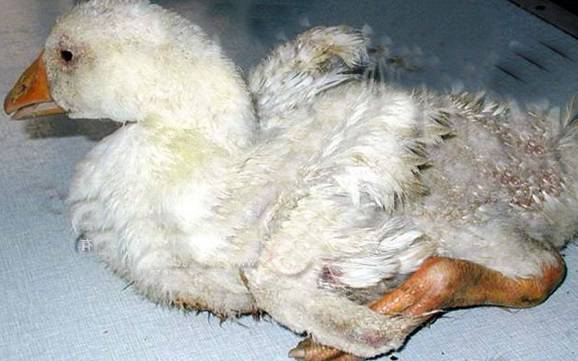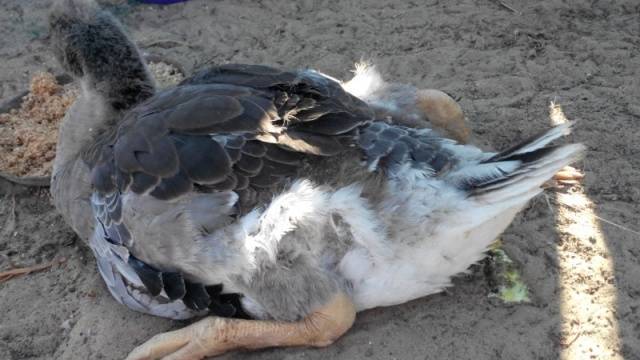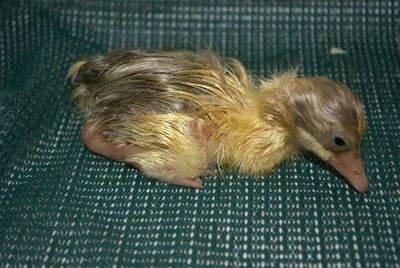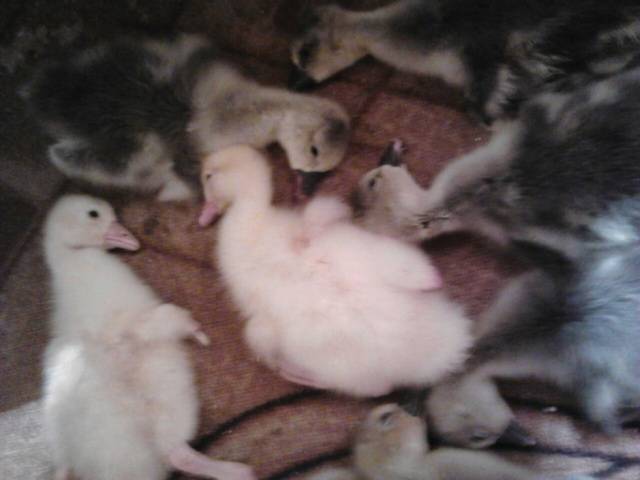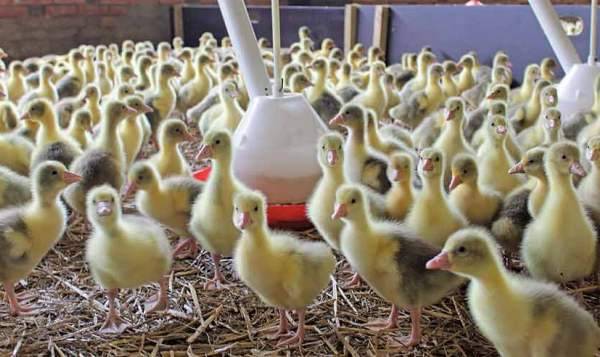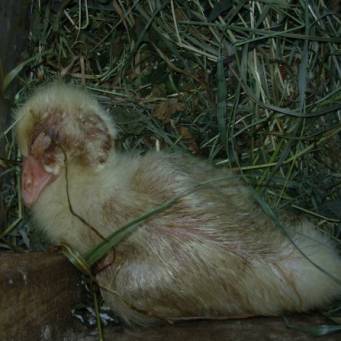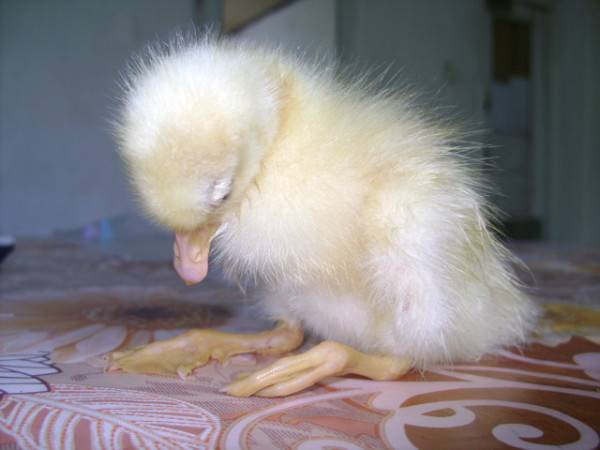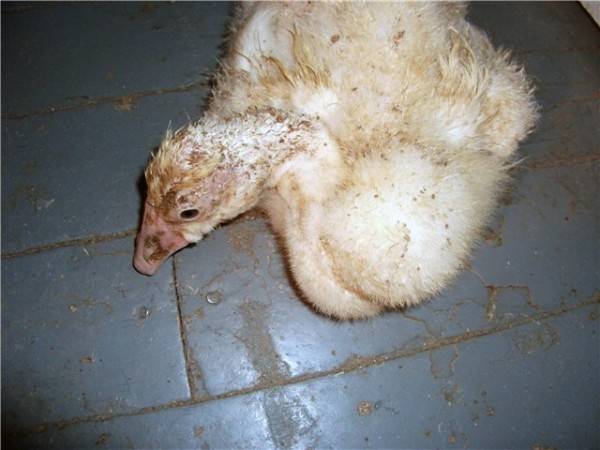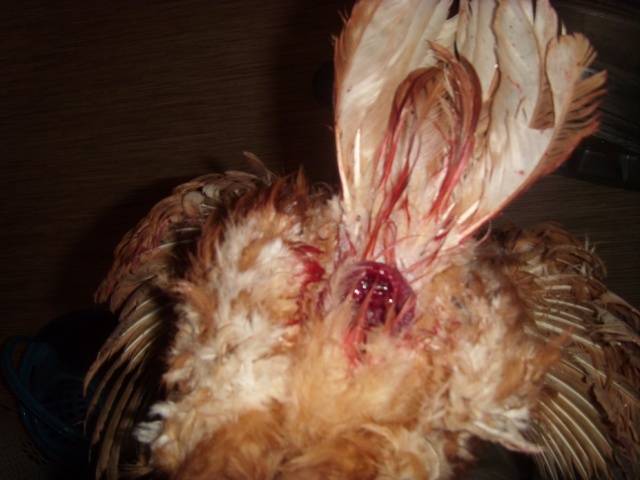Content
Just as the pheasant family suffers from the same diseases, so the duck family, which includes geese, ducks and swans, suffers from the same diseases.
And many diseases are the same for everyone. These include salmonellosis, colibacillosis, pasteurellosis.
But very often the acquaintance of private owners with goose breeding begins with viral enteritis, with which the purchased goslings were infected while still in the incubator. Although, most likely, the goslings were infected with salmonellosis, since enteritis is an inflammation of the intestine, which can be caused by both infectious causes and any non-infectious factors. For example, by eating stinging substances.
Duck plague (duck enteritis)
The disease is common for ducks and geese, which is also called viral enteritis of ducks. The causative agent is a DNA-containing herpes virus. In case of viral enteritis of ducks, multiple hemorrhages occur in the liver, lungs, spleen, pancreas and thyroid glands, and kidneys. Observe the defeat of the gastrointestinal tract of the bird, exhaustion, the development of abscesses.
Enteritis of geese differs in a similar characteristic, but the diseases have different signs and duration.
Duck viral enteritis symptoms
The incubation period of the disease is from 3 days to a week, it can be up to 20 days.
The disease has three forms: hyperacute, acute and worn out. With a hyperacute form, an outwardly healthy bird suddenly dies. In acute cases, birds observe: thirst, watery diarrhea, semi-paralysis of the limbs. Goslings cannot walk normally, fall to their feet, cannot stand. Food refusal and eye diseases are also present: conjunctivitis and eyelid edema.
The erased form of the disease occurs in dysfunctional herds of birds, where this type of disease has been walking for more than the first generation. Such geese have developed immunity and clinical signs of enteritis are manifested in an erased form: depression, decreased appetite. At the same time, the mortality of young animals from enteritis reaches 90%.
Duck enteritis treatment
There is no specific treatment for enteritis. For prophylaxis in prosperous farms and threatened areas, the duck plague virus vaccine is used in accordance with the attached scheme.
Disease prevention
Currently, duck enteritis is not registered in Russia, which does not cancel the requirements for compliance with sanitary and veterinary measures to prevent the penetration of the virus into farms. All birds that may be exposed are vaccinated with live vaccines as directed. In case of ducks enteritis, all sick and suspicious birds are slaughtered and disposed of. A thorough disinfection of the premises is carried out with a solution of caustic soda, formaldehyde or bleach. The imported bird is quarantined for 1 month.
Goose viral enteritis
Another attack that geese are prone to. It affects the digestive tract, lungs and liver. Accompanied by the death of goslings. The mortality rate can be 100%.The causative agent is a DNA-containing virus, but from a completely different family, not related to duck plague. Goose viral enteritis affects only geese and musk ducks.
The disease has other names:
- goose flu;
- disease Hold;
- hepatitis;
- gastroenteritis;
- plague of geese;
- viral hepatitis in goslings;
- goose influenza;
- ulcerative necrotizing enteritis.
The virus is resistant to substances used in the conservation of biological products: ether and chloroform. For up to 2 years, it can remain active in 40% glycerin. At a temperature of 4 ° C, it can remain active for up to 5 years. Dies after an hour at a temperature of 60 ° C, at 70 ° C the virus is inactivated after 10 minutes. Sensitive to common disinfectants: formaldehyde solution inactivates the virus after 15 minutes.
Symptoms of viral enteritis in geese
The incubation period lasts from 2 to 6 days. The course of the disease is acute. The duration of the illness is from 2 days to 2 weeks.
Goslings under the age of 10 days huddle together, tremble, strive for warmth. In the first 5 days after the appearance of a sign of the disease, from 60 to 100 percent of the goose livestock dies.
After 10 days, the goslings fall to their feet, lower their wings, pluck each other's feathers, lag behind in growth, and do not respond to sounds. Mortality of young animals of older age up to 30%.
With a chronic course of the disease, 20-30% of geese stop growing by the age of 7 weeks and enteritis is observed. In a chronic course, mortality is normally 2-3%. In severe cases, up to 12%.
In adult geese, the disease is asymptomatic.
You need to buy goslings only in farms that are guaranteed to be safe from viral enteritis of geese.
Treatment of viral enteritis in geese
The disease, fortunately, is treatable, albeit in a difficult way. Goslings under the age of 5 days are injected with serum or blood of convalescent geese for prophylaxis or treatment. Blood is injected subcutaneously, twice, with an interval of 2-3 days. The injection is made into the neck area in a volume of 0.5 - 2 ml.
Antibiotics are also used to suppress secondary infections.
But it is easier to prevent an outbreak of the disease than to look for the blood of recovering geese.
Disease prevention
Compliance with veterinary instructions for the prevention of viral enteritis in geese. For the prevention of enteritis, virus vaccines are used for goslings and adult geese according to the instructions.
In the event of a disease outbreak, the import and export of hatching eggs and live geese is prohibited. Incubation of geese eggs is allowed only for slaughtering for meat on the farm itself. Clinically sick goslings are slaughtered, those who have recovered are raised for up to 2.5 months, after which they are slaughtered for meat.
Daily goslings of later broods are pierced with convalescent serum subcutaneously. Restrictions can be removed only 2 months after the last recorded case of the disease and disinfection.
Staphylococcosis of birds
The second name is micrococcosis. The disease is caused by pathogenic staphylococci. It is manifested by symptoms of blood poisoning, dermatitis, arthritis, inflammation of the infraorbital sinuses, cloacites.
Symptoms of staphylococcosis in geese
The disease usually occurs with trauma. In ducks and geese, it is expressed in diseases of the legs and bones: polyarthritis, osteitis, ostemyelitis, paralysis of the limbs, inflammation of the tendons. In addition, the birds have intestinal upset and intense thirst.
In the acute course of the disease, in case of infection, goslings under the age of 10 days of age die within 6 days. At an older age, depression and diarrhea.
With a subacute and chronic course, inflammation of the joints and extremities occurs, at the end, gangrene of the wings may develop, which is preceded by hemorrhagic edema. Cloacitis may develop.
In the chronic course of the disease, appetite also decreases and exhaustion progresses. Death occurs 2 to 3 weeks after the onset of the disease. The death of birds is not one hundred percent, but the surviving bird recovers slowly and limps for a long time.
Treatment and prevention of the disease
It is possible to treat only symptomatically, alleviating the condition of a sick goose, since the treatment of staphylococcosis directly has not been developed.
As a preventive measure, sick and suspicious geese are slaughtered. The feed is examined for the presence of staphylococci. Aerosol disinfection of the premises is carried out, without removing geese from there, with solutions of lactic acid, triethylene glycol or resorcinol. Dispose of litter and droppings.
Goslings on grazing are recommended to be treated with antibiotics of the penicillin group, to which staphylococcus is sensitive.
Salmonellosis
The disease is common to domestic and wild mammals and birds. A person can also become infected, so although leptospirosis can be cured, care must be taken when dealing with a sick animal.
Salmonellosis is caused by a group of bacteria, often specific to each species. Young animals are especially susceptible to salmonellosis.
Symptoms of the disease
In birds, salmonellosis occurs in acute, subacute and chronic forms. The incubation period of the disease is up to 3 days.
In goslings under the age of 20 days, salmonellosis will proceed in an acute form, in which there is a decrease in appetite, drowsiness, diarrhea, purulent conjunctivitis. Salmonella also affects the central nervous system, which causes seizures. Goslings tilt over on their backs, jerk their heads randomly, make swimming movements with their limbs. Mortality in acute course can reach more than 70%.
At an older age, salmonellosis occurs in a subacute form. Symptoms include purulent conjunctivitis, rhinitis, inflammation of the joints of the extremities, and diarrhea.
After three months, geese are already sick in a chronic form, characterized by diarrhea and lagging behind in development and growth.
Salmonellosis treatment
Treatment in birds is carried out in a comprehensive manner, using specific drugs and immunostimulants.
Before treating a goose for any disease, you need to conduct laboratory tests to differentiate diseases. Often this is not possible and then you have to treat geese at random in the hope of hitting the target. In particular, in the video, the owner suggests coccidiosis in goslings, which they contracted from adults. But it is stipulated that he soldered the goslings with an antibiotic for three days. Antibiotics do not work on coccidia. This means that either the goslings actually had something else, or the disease passed into a chronic stage. Perhaps there was just salmonellosis.
Danger of combining small goslings and old geese into one flock.
Non-communicable diseases in goslings
Non-infectious diseases of geese are often the same as those of other birds. Goose goiter catarrh is similar to the same disease in turkeys, and oviduct prolapse is no different from oviduct prolapse in chicken.
In the absence of infection, goslings fall to their feet for the same reasons as turkeys:
- large body weight, at least twice the live weight of a wild ancestor;
- lack of a fairly spacious walk and ultraviolet radiation;
- poor quality feed;
- traumatic injuries of the paws.
In goslings, the problems of physical weakness of bones and ligaments are more pronounced than in turkeys, since the goose spends part of the time in the water and does not travel long distances on foot.
Oviduct prolapse
Birds have this problem due to too large eggs or inflammatory processes in the reproductive organs. Contrary to the advice on the Internet, practice has proven that this disease cannot be cured and the bird will have to be slaughtered.
In mild cases, the oviduct can be adjusted back, but such a bird will no longer be carried. Therefore, it will be useless in the household.
If you let the bird walk with the fallen oviduct, it will pick up infections and fall on its own.
Blockage of the esophagus in a goose
May occur from feeding dry food with limited water supply. Often, owners, not wanting to "swamp" in the poultry house in winter, restrict the birds at this time of the year in the water or believe that the geese can easily get drunk by eating snow. Both of these opinions are wrong and water should always be freely available.
Symptoms of the disease
Excited bird behavior, shortness of breath, open beak, wobbly gait. The esophagus and goiter press on the air channel, and the bird can die of suffocation.
Treatment and prevention of the disease
For treatment, you can try to inject the bird with sunflower or liquid paraffin and squeeze the contents of the esophagus out with your hand. Ensure constant access to water for prevention. Geese drink a lot.
Conclusion
The main problem of goose breeders is infections, which goslings become infected with while still in the incubator. To prevent troubles when buying goslings or hatching eggs, you need to require veterinary certificates. And for the normal development of healthy goslings, you need to provide them with a spacious walk with the possibility of grazing.
